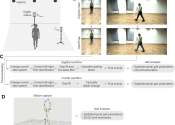Too much treadmill? This could help your shin splints
Good news for all the treadmill runners who suffer from stubborn and painful shin splints: A little outdoor gait training may help, new research suggests.
Jul 2, 2024
0
0
Good news for all the treadmill runners who suffer from stubborn and painful shin splints: A little outdoor gait training may help, new research suggests.
Jul 2, 2024
0
0

A surgery that helps 7- to 10-year-olds with cerebral palsy walk also helps older kids and teens with the condition, a groundbreaking study shows.
Jun 21, 2024
0
0

How does your gait—or how you walk—relate to your brain health? Considerably, says Dr. Farwa Ali, a Mayo Clinic neurologist who specializes in movement disorders. Assessing a person's gait can offer insight into various ...
Jun 7, 2024
0
0

Investigators have applied artificial intelligence techniques to gait analyses and medical records data to provide insights about individuals with leg fractures and aspects of their recovery.
Apr 10, 2024
0
0

Researchers at Kennedy Krieger Institute and Johns Hopkins Medicine have developed a new, accessible approach to analyze a patient's walking ability and stances more effectively. Following numerous tests, they determined ...
Mar 28, 2024
0
9

A first-of-its-kind study suggests that to detect subtle gait impairments in older adults that often are prevalent in the early stages of cognitive decline, "throw them a curve."
Mar 12, 2024
0
81

Parkinson's disease patients who experience freezing of gait (a sudden inability to initiate or continue movement, often resulting in a fall) wake up several times during the night, feel sleepy during the day, and have REM ...
Mar 5, 2024
0
0

A good shoe can make a huge difference for runners, from career marathoners to couch-to-5K first-timers. But every runner is unique, and a shoe that works for one might trip up another. Outside of trying on a rack of different ...
Jan 24, 2024
0
29

In a rural village near Guadalajara, Mexico, Maria Magdalena Valencia Juares, known as Elena, has to climb 120 stairs to get to her home on the top of a hill. It's a source of exercise for the 70-year-old and the connection ...
Jan 17, 2024
0
1

Gait-related disturbances adversely affect the quality of life of patients with Parkinson's disease (PD), a condition affecting millions worldwide. Although various pharmacological, surgical, and rehabilitative treatments ...
Aug 8, 2023
0
4

Gait is the pattern of movement of the limbs of animals, including humans, during locomotion over a solid substrate. Most animals use a variety of gaits, selecting gait based on speed, terrain, the need to maneuver, and energetic efficiency. Different animal species may use different gaits due to differences in anatomy that prevent use of certain gaits, or simply due to evolved innate preferences as a result of habitat differences. While various gaits are given specific names, the complexity of biological systems and interacting with the environment make these distinctions 'fuzzy' at best. Gaits are typically classified according to footfall patterns, but recent studies often prefer definitions based on mechanics. The term typically does not refer to limb-based propulsion through fluid mediums such as water or air, but rather to propulsion across a solid substrate by generating reactive forces against it (which can apply to walking while underwater as well as on land).
Due to the rapidity of animal movement, simple direct observation is rarely sufficient to give any insight into the pattern of limb movement. In spite of early attempts to classify gaits based on footprints or the sound of footfalls, it wasn't until Eadweard Muybridge and Étienne-Jules Marey began taking rapid series of photographs that proper scientific examination of gaits could begin.
This text uses material from Wikipedia, licensed under CC BY-SA